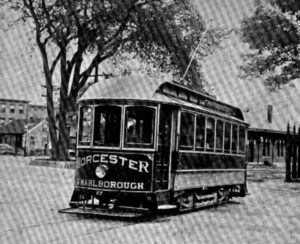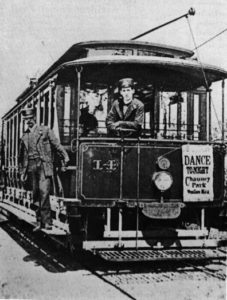By Brett Peruzzi, Contributing Writer

Marlborough – A century ago, the city of Marlborough had an arguably more robust public transit system than it does today. It was possible to travel south to the Southborough border, north to Hudson, and east and west across the city on Main Street, all thanks to the Marlborough Street Railway Company. Electric trolleys, also known as streetcars, were a common mode of conveyance in numerous cities in the United States beginning in the 1880s. By 1895 the country had nearly 900 trolley companies running on over 10,000 miles of track.
It was possible to travel to additional destinations outside Marlborough using other trolley companies. The Marlborough and Westborough Street Railway ran from North Grafton, Westborough and Southborough to Marlborough, providing transportation to Westborough’s Lake Chauncy, which had an amusement park and dance pavilion, and the state hospital. The Worcester and Marlborough Street Railway also had a trolley line that ran from Marlborough westward through Northborough and Shrewsbury to Worcester.
The Marlborough Street Railway Company began running electric trolley cars in 1889, after a brief period where they were horse-drawn.
“Sam Boyd, a prominent shoe manufacturer and entrepreneur, wanted to have the first electric trolley system in the country,” said Bob Kane, vice president of the Marlborough Historical Society. Marlborough’s wasn’t the first, but it was one of the early electric systems.
“Boyd started the trolley company to carry his shoe workers around the city,” explained Kane. “He didn’t start it to make money initially, but to help his factories and as a convenience for his workers so they could easily get to work on time and even go home for lunch.”
The fare was generally five cents, about $1.40 in today’s dollars. The trolley system originally had switches to allow cars approaching each other to turn off to the side, but it later had two sets of rails so trolley cars going in opposite directions could pass each other.
The Marlborough Street Railway Company operated as a single system with other trolley companies in Framingham and Southborough. Combined, they had 22 miles of track and ran 16 closed and 22 open passenger cars, seven snowplows, and four work cars. The Marlborough Street Railway’s trolley barn, or car house, and repair shop were located south of downtown on Maple Street, near the intersection with Valley Street. A brick power station was located next to the trolley barn.
The Marlborough Street Railway was brought down at least partially by three serious accidents that cost the company a lot of money. It was placed into receivership in 1902, and the following year its assets and properties were sold. Soon afterward, a new company, the Marlborough and Framingham Street Railway, was formed as the new entity.
As the years went by, there were more trolley company consolidations. In 1904 the Marlborough and Framingham Street Railway was consolidated into the Boston and Worcester Street Railway company. The larger regional companies like this one continued to operate successfully for the next 20 years or so, but it went into receivership itself in 1925, and was reborn in 1927 as the Boston, Worcester and New York Street Railway. But private automobiles were becoming more common, decreasing the demand for trolley service.
Some historical accounts believe the automobile, tire, and oil companies also made a concerted effort to drive the electric trolley companies out of business to increase the market for their products. Between 1925 and 1928, all of the trolley systems that served Marlborough were converted to buses. “But when buses took over they didn’t do all of the routes the trolleys did,” said Kane. Some of the old trolley cars lived on for a time, purchased cheap after they had been junked, and were converted into small diners.
Photos/courtesy Marlborough Historical Society












